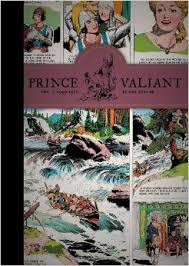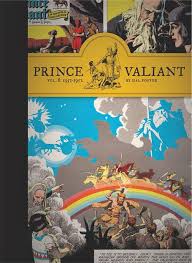Prince Valiant’s story continues in these two volumes produced by Fantagraphics. This time, they are solely the work of John Cullen Murphy, Hal Foster’s successor, other than the 2000th installment of the strip in Volume 20, which summarizes the key points of Valiant’s story and was drawn by Foster. The years of these volumes run from 1975-1978. I’ll summarize a few of the highlights here. But be forewarned there are some spoilers.
Volume 20 includes more of Prince Arn, Valiant’s son, who has become one of my favorite characters as we have watched him grow up. Here he meets twin princes, one of whom ends up murdering the other.
Aleta, Valiant’s wife, is another favorite character of mine. This time she and Valiant return to the Misty Isles, and on the way, Hashida the Sorcerer falls in love with her, kidnaps her, and hypnotizes her. Of course, Valiant rescues her, but Aleta won’t let him kill Hashida, explaining to him that if he kills everyone who loves her, he’ll decimate the male population.
Aleta’s banished sister, Helene, figures in the story also. Years ago, her husband plotted against Aleta. Now the husband is killed in a gambling fight and she is taken as a prize by the winner, so Valiant has to rescue her also.
Finally, Arn is sent to Camelot to begin to learn statecraft so he is ready someday to be a king.
In addition, a short but interesting essay is included at the end of Volume 20 by Michael Dean about stereotypical racial characters in the Valiant strip, particularly a very short segment in which a moneylender’s depiction led to an outcry by Jewish readers that he was a stereotype, even though the strip did not name him as a Jew. While Murphy was writing the strip at this time, Foster saw fit to respond with an apology. The essay mentions that in earlier strips Foster was sensitive to depictions of Jewish characters, but also that a larger study of racism and stereotypes in Foster needs to be made—something I agree with, for there are a lot of stereotypical racial characters in the strip, but at the same time, the strip is partly a product of its time and also has the problem of being very wide-reaching in allowing Valiant to travel over most of the known world at the time and consequently to come into contact with people from many different lands, some of whom have to be villains and some decent people to add interest to the plots. That is an oversimplification so I hope someone will write an in-depth article or book on racism in the strip.
Volume 21 begins with an interesting article about the “historicity” of Prince Valiant, which discusses the strip’s connection to the Arthurian legend and gives a fair overview of the development of the Arthurian legend and its sources while noting that Foster made reference to many events such as the quest for the Holy Grail and the love story of Tristan and Iseult while going off into Valiant’s own stories rather than focusing on the Arthurian ones. What is important and interesting here is how hard Foster tried to be historical, clearly setting the strip in the fifth and sixth centuries in the time when the Roman Empire had fallen and before the rise of the high Middle Ages. In fact, Foster was writing one of the earliest versions of Arthurian fiction that tried to be historical rather than being simply romance, although a few Arthurian novels predate it such as W. Barnard Faraday’s Pendragon (1930).
While there are several stories in Volume 21, for me the best were Valiant’s daughter Karen’s desire to become a warrior queen, and then the story of how Arn travels to Thule and reunites with Lydia, daughter of King Haakon, whom he has fallen in love with. Sadly, Lydia dies in a tragic accident, leaving Arn mourning. I trust Arn will find love in a future volume—there are even hints by the end of this one that he will. Meanwhile, Arn grown a mustache, showing us he is now fully grown.
The upcoming Volume 22 promises to return us more closely to the Arthurian plot as Arthur’s half-brother Mordred plots to usurp the throne. Stay tuned for more.
____________________________________________________
Tyler Tichelaar, PhD, is the author of The Children of Arthur series, which includes the novels Arthur’s Legacy, Melusine’s Gift, Ogier’s Prayer, Lilith’s Love, and Arthur’s Bosom. He has also written the nonfiction scholarly works King Arthur’s Children: A Study in Fiction and Tradition and The Gothic Wanderer: From Transgression to Redemption, plus numerous other books. You can learn more about Tyler at www.ChildrenofArthur.com and www.MarquetteFiction.com.



